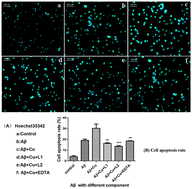Two macrocyclic polyamines as modulators of metal-mediated Aβ40 aggregation†
Abstract
Dysfunctional interactions of amyloid-β (Aβ) with Zn and Cu ions are proved to be related to the etiology of Alzheimer's disease (AD). Disruption of these metal–Aβ interactions using metal chelators holds considerable promise as a therapeutic strategy to combat this incurable disease. Herein, we report that two cyclam derivatives (L1 and L2) are capable of modulating Zn2+/Cu2+-mediated Aβ40 aggregation, reactive oxygen species (ROS) production, and neurotoxicity. These chelators were found to inhibit the metal-induced Aβ40 aggregation, dissociate metal–Aβ40 aggregates and restore the metal-induced β-sheet structure of Aβ40 to its random coil conformation, as observed by BCA protein assay, thioflavin T fluorescence and circular dichroism spectroscopy. Moreover, preliminary investigation of SH-SY5Y cells indicates that L1 and L2 can diminish the neurotoxicity of metal–Aβ40 species, control metal–Aβ40-triggered ROS production and protect cells against apoptosis. These observations warrant the further investigations of L1 and L2 as potential anti-AD agents.


 Please wait while we load your content...
Please wait while we load your content...